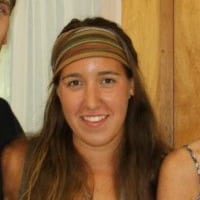blogSince embarking upon my own short ultrarunning career, I’ll admit I’ve pined for the West, desiring to run in the mountains of Colorado and on the trails circling Lake Tahoe. For someone who has lived in a small, Indiana town all her life, I thought escaping the Midwest was the key to a more, well, diverse life. However, after running ultras and races throughout the Midwest—Minnesota, Indiana, and Ohio—I have come to appreciate the uniqueness my backyard has to offer. Ultrarunners who call the Midwest their home already know this. The Midwest’s unique trails and the people who run them create a distinct trail running environment you don’t find anywhere else in the world.
Though I am still learning to appreciate them, there are many people who call the trails of the Midwest their only true home. For this article, I gathered up a group of Midwestern loyalists, including race directors of events such as the Indiana Trail 100 (IT100) and Ice Age Trail 50 Mile (IAT50). I spoke with veterans who have decades of running-bib accumulation and elites who have chosen to make a home in the area. I have acquired a general consensus of opinion about the Midwest ultrarunning scene: the Midwest is more than just rolling hills between the lakes.
Pre-Race Prep
Looking into the history of the Midwest ultra scene, you may be surprised at what you find. Despite their current residences, there are many Midwest-bred runners who are dominating ultra races throughout the country.
Zach Bitter, from Marinette, Wisconsin, was UltraRunning magazine’s winner of the 2013 Ultra Performance of the Year for his 100-mile American record/12-hour track world record run at the 2013 Desert Solstice Invitational. Cassie Scallon, born in Richmond, Wisconsin, won the 2014 Sean O’Brien 50 Mile. And we gladly remind people that Proctor, Minnesota is the birthplace of the legendary Scott Jurek, before he moved West and dominated the Western States 100 and other ultras.
The Midwest is also the birthplace of some of the nation’s first ultra races. In 1982, the IAT50 in Wisconsin was founded, making it one of the oldest ultras in the country. But it’s also a popular and competitive race, having been part of the 2014 Montrail Ultra Cup.
Jeff Mallach, a past participant, volunteer, and now IAT50 race director, said his registration process’s evolution reveals its increase in popularity. “When I took over the race five years ago, the race had never sold out in those 28 years. Three years ago, it sold out in 10 weeks, last year in 10 days, and this year in three hours.” According to Mallach, IAT50’s reputation and dedicated long-time runners have led to the race becoming a ‘bucket-list’ trail race. The draw comes from the competitive field and the speedy, beautiful trails of Kettle Moraine State Forest. The race receives a lot of interest from elites looking to break course records or qualify for other races in the case of this past year’s Montrail Ultra Cup, but it is also a favorite among veterans, some of whom have completed the race over 20 times, becoming part of the race’s 1,000-mile club.

Runners speed onto the trails of the 2014 Ice Age Trail 50 Mile. Photo: Jim Clapsaddle
The 32nd IAT50 was run this past May and it welcomed new and veteran runners. Kaci Licktieg, the 2014 Rocky Raccoon 100 second-place finisher, traveled the ground that established runners Ann Trason in 1993 and Pam Smith in 2001 have already conquered as she went on to win and set a new course record. Timothy Olson, who grew up in Wisconsin, ran the race in 2012 for the first time. He wrote in his personal blog, “The singletrack was a lot of fun to run. There was not really much climbing or descending which I am more used to, but there were enough roots and rocks to add some flavor and make it interesting as the miles went on.”
General Information
Due to the popularity of Ice Age, people also line up at other race starts in Kettle Moraine State Forest, including the Kettle Moraine 100 Mile and 100k, Glacial Trail 50 Mile and 50k, and The North Face Endurance Challenge 50 Mile-Wisconsin. The creation of new races in just this one area represents how the needs of the rapidly growing ultra community are being met, as well as showing how the world of running is changing in general.
For Mike Pfefferkorn, the idea for Indiana’s first 100 miler sparked after a motivational and welcoming training run for his own first hundred, the Mohican Trail 100 (MO100) in Ohio. “We were so far behind the runners in Northeast Ohio and we had to do something to increase the talent level in our state of Indiana,” he said. With the help of others with similar thoughts and aspirations, the Indiana Trail 100 was born within the Chain O’ Lakes State Park near Albion, Indiana. In its second year in 2014, the race is part of the Midwest Grand Slam series, and has grown to accommodate 330 participants on its “lightning fast” six-loop course, according to Pfefferkorn. Filling the gap in Indiana ultras, the race was planned and designed to be an established race in the state for future years to come. We can also grant fat-ass events, and a general desire to share one’s daily hometown trails, with the creation of the many legitimate races we now have.
Residing in Crystal Lake, Illinois, Geoff Moffat is a race director for two fairly new races, the Frozen Gnome 50k/10k and Earth Day 50k/15 Mile. Run for the second year in January of 2014, the Frozen Gnome 50k evolved from a fat-ass event. “It is a small, organic race that was born out of our running group’s desire to share our trails with the community,” he said. The Earth Day 50k was created to introduce people to the trails, Moffat said.
This mentality can be seen among many of the new ultras popping up through the area, contrasting against the growing showier races, like The North Face Endurance Challenge runs.
“Curmudgeons sometimes look at ‘glitzy’ events like The North Face and grumble, ‘Back in the old days of ultrarunning you didn’t get all these frills,’” Mary Gorski said, mimicking some of the old timers with whom she runs. “It didn’t cost so much, it was off-beat, not so mainstream, but now…’” Gorski, from Milwaukee, Wisconsin, who has been competing in ultramarathons throughout the country for 20 years, said the glitz and mainstream feel has helped events draw more people to the sport of running. “I can be a curmudgeon, too, sometimes,” she said. “I like the fat-ass events, but I also like what some of the bigger events like The North Face have done. It’s fun to be among the elite, but if a person wants to just run or do other types of ultras, there are still plenty of venues.”
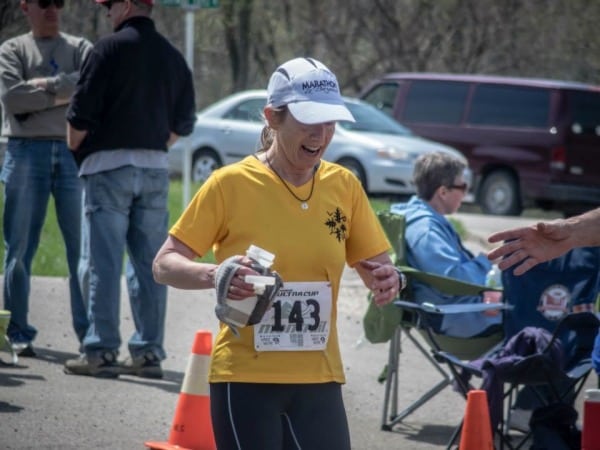
Mary Gorski at the Ice Age Trail 50 Mile in May. The 2014 race was her 12th time running the Wisconsin classic. Photo: Kristine Hinrichs
Course Description
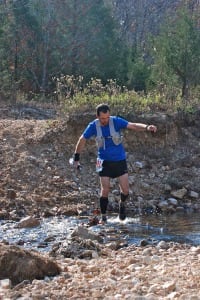
A runner during the Ozark Trail 100. Photo: Chris Wristen
But what exactly is ‘the Midwest trail,’ you ask? You’ve got dirt, trees, some roots, and rocks—typical trail fashion throughout the country, right? Yet, ‘the Midwest trail’ embraces unique elements of the environment. One race, the MO100 in Loudonville, Ohio, takes place on 95% runnable trail through the canopy-enveloped, lush Mohican Memorial State Forest. According to the race , the challenging course, hosted in June, should have a place on every runner’s must-do list. Just be ready for some hot and humid running!
And in southern Indiana, the infamous, muddy, Dances With Dirt Gnaw Bone Relays, 50 mile, and 50k is another race to check off on the Midwest-ultras-to-run list. Run through Brown County State Park in Nashville, I can only rely on former participant comments to convince those interested that, yes, Indiana has elevation and, yes, we know how to throw a good after party. Other Dances with Dirt races take place at other times of the year in Baraboo, Wisconsin and Hell, Michigan (and Florida, too).
However, the lack of elites toeing the line of these Midwest races has not gone unnoticed. Some link a mistaken belief that the Midwest has nothing but flat, easy, runnable courses, and boring scenery to the shortage of elite racers.
David Riddle, the 2013 IAT50 winner and Midwest resident since 2010, said there is an absence of interest in the style of trails in the Midwest. “I enjoy the accomplishment of tagging a peak and the views that come along with the big climbs,” he said, “but I also can find a different kind of beauty in Midwest trails.”
Features of the Midwest may not call for trekking poles and gaiters worn around our trail shoes, but we do offer terrain that will require some pain, both physically and mentally. Loops are one of those things. Due to limitations of state-park locations, national forests, and land space in general, courses looped around six or more times to get in the 100-mile distance are common in the area. “There is a subtle attitude among even some of the sport’s biggest supporters that loop courses violate the very essence of trail running,” said Riddle, adding his preference of having the ability to fun fast rather than having to powerhike parts of the course. “I wouldn’t be a trail runner right now if it weren’t for loop courses.”
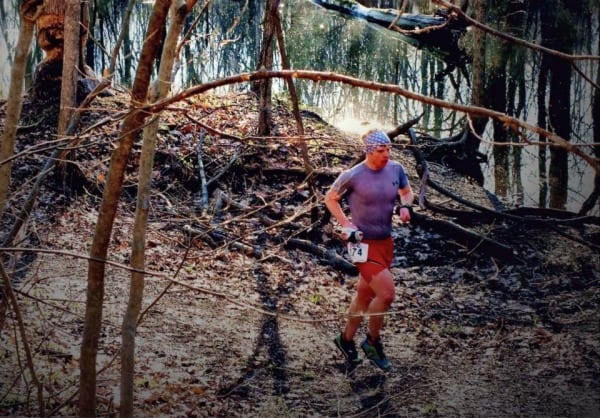
A runner sloshes through the mud of the second annual Indiana Trail 100. Photo: Steve Pfefferkorn
Travis Liles, co-director of the Mark Twain 100-Mile Endurance Run in Missouri, summed up the ambiance of Midwest ultrarunning perfectly: “We have trail running here, not mountain running.” Liles is a finisher of the Tahoe Rim Trail 100 and Leadville Trail 100. He said with confidence that races in the Midwest, like those raced in the Mark Twain National Forest, includes technical features such as creek crossings and various dirt surfaces, from extremely rooted to very smooth. Winding singletrack sections promote a faster running speed, he added. And the continuous ups and downs, rather than steep mountains, force runners to constantly keep moving along the trails.
“Overall are our races harder? No,” he answered himself. “They just have their own little nuances, but to assume they are easy just because there are no 2,000-foot climbs would be a mistake.”
Ohio elite Connie Gardner also commented that people come to the Midwest to run races like MO100 or Burning River 100 (also in Ohio), adding to Liles’s flat-racing observations. The 15-year ultrarunner says you have to have a running strategy to help cope with the constant movement.
“You have to be smart,” added Gardner. “In a flat race, you have to put those breaks on yourself. When you have to run every single step on a flat course, it’s hard.”
Gardner also mentions the surprise addition of the heat and humidity by outside racers. In the summer, temperatures can rise to 90 to 100 degrees Fahrenheit, in addition to humidity levels of 70 to 80 percent.

Runners wind through the fast, flat trails of the Indiana Trail 100. Photo: Steve Pfefferkorn
But on the other hand, the Midwest’s cold temperatures can be another ‘fun’ feature for winter races. Runners of 2011 December race, called The Huff 50k, in Albion, Indiana, ran on top of frozen trails in between the passages of treading through waist-deep water. And, as we all remember and are still trying to forget, the polar-vortex winter of 2014. Temperatures dropped to negative numbers, freezing the trails so much that Yaktrax and spikes didn’t stand a chance.
Now, most agree flying to France to run the Ultra-Trail du Mont-Blanc, rather than arriving at the Detroit, Michigan airport to run the Hallucination 100 of the Run Woodstock race series may be the more exotic choice. And we understand the specialness of being a part of the legendary “Western States club” versus arriving at the start at a newly founded race. Yet Pfefferkorn, with his two-year-old IT100, keeps a positive outlook for the Midwest and outside participation. “In terms of attracting runners outside of our region, you have to be successful from the inside out, meaning that the growth has to start locally first, then work its way out into other regions,” he said.
UltraRunning magazine’s 2013 Ultrarunner of the Year, Michele Yates, selected IT100’s inaugural race for her first attempt to break the women’s American 100-mile trail record. Due to unfavorable weather conditions, Yates was unable to achieve that goal, however she wrote on her personal blog, “Put this race on your race calendar for next year-under normal conditions IT100 would be a phenomenally fast course.”
As for the race, which takes place every April, Pfefferkorn says his attitude toward elites is, “If they show up, terrific. We hope they have a good time. If not, no worries!”
Post Race: What’s Next?
Whether it was the chicken or the egg—the birth of new races or the rise in runner participation—the Midwest ultra community is definitely growing in reputation and stature. We can claim that events such as the Midwest Grand Slam and the accumulation of trail running clubs throughout the area are helping the sport of ultrarunning grow almost as quickly as our cornstalks. Nevertheless, in comparison to the rest of the country, and with the ongoing transformations the sport is undertaking, how does the Midwest stack up?
Karen Erba, an Indiana-based runner, believes the Midwest is on the brink of much growth thanks to events like the Slam, new races, and veterans and running clubs introducing new people to the sport. Erba was an experienced marathoner before she became hooked on the idea of running 100 miles. She dove into the summer of 2012, signing up for and finishing four ultras. The following year, she completed the Midwest Grand Slam, tackling another five 100 milers that summer. “I think it’s an exciting time to be an ultrarunner in the Midwest,” she said. “We’re seeing a definite rise in the number of races and participation. A person could race as much as he or she likes and never need to leave the region!”
In Riddle’s opinion, the Midwest is slowly climbing to the level of the rest of the nation, but the lack of mountainous terrain will always be a hindrance to total equality. Instead, he believes the true test for the future of ultrarunning lies in the balance between the “speedsters” crushing 50ks and 50-mile course records, and races like the Tahoe 200-Mile Endurance Run, which had a successful inaugural production this year. “Finding that balance between encouraging robust competition and allowing those who want to participate for other reasons will be critical to the continued success of the sport, not just in the Midwest, but nationwide,” he said.
Also on the horizon, be it viewed from the mountaintop or a gravel road in Illinois, we are seeing bursts of popularity of stage races, six-hour, 12-hour, or 24-hour races, and even a few of those Forrest-Gump-style, ‘let’s see how far our bodies can go’ endeavors. There is always something new, and something that redefines the ‘ultra-endurance’ label.
All in all, the community of ultrarunning is going strong, as a whole nation and within our hometowns. Will it lose some of its trendiness? Will it begin to level out across the nation? Who knows?
But what I do know is that ultrarunning in the Midwest is no longer hiding in the background. Despite our lack of cloud-scraping peaks and infamously known difficulty rates, Midwesterners value one thing: running our hearts out 100 percent on our 100-percent runnable trails.
The Midwest To-Run List
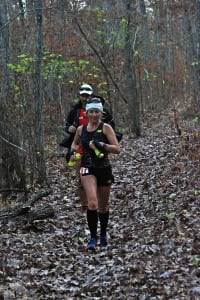
Katie DeSplinter runs the Ozark Trail 100. Photo: Chris Wristen
After reading many race recaps, course descriptions, and race-director testimonials, I have narrowed down the top-five ultramarathons to run in the Midwest. Chosen for location, scenery, reputation, speediness, and difficulty, I hope one of these inspires the outsider, or fellow Midwesterner, to jump onto UltraSignup.
- Classic — Ice Age Trail 50 Mile: With continuous hills, the race’s terrain is comprised of mostly singletrack, rocky, and rooted trails. Through hardwood forests, pinewoods, and prairies, the race is a classic example of Midwest running.
- Peace’n Out — Run Woodstock: From five to 100 miles, the Run Woodstock Race Series is a party of a run, starting on Friday night and ending with the last runner on Sunday. Hosted in September in Pinckney State Park in Michigan, the 100-mile course embraces six loops of runnable singletrack, rail, and horse trails. The race also features weekend-long karaoke, yoga, and a peace-loving good time.
- Old School — Mohican Trail 100: The MO100 is the nation’s fifth-oldest ultramarathon and a qualifier for UTMB in France. Whether veteran or newbie, the MO100 welcomes each finisher with a buckle and awards those who have completed the race more than 10 times with a direct entry and a custom 1,000-mile finisher buckle. And for those back-of-packers, The Last of the Mohicans award is given to the last runner to cross the finish line within the 32-hour limit.
- Mind-Numbing — The Potowatomi Trail Runs: Originally called the McNaughton Trail Runs, these races are run on a 10-mile loop through the McNaughton Park in Pekin, Illinois. The race hosts 30-, 50-, 100-mile, and 150-mile race options, and they are adding a 200 miler for 2015. If the relentless continuation of circles and rolling hills is not difficult enough, planning what to bring for the unexpected Midwest April weather will be. Described on the website as “Easier than Barkley, cooler than Badwater, lower altitude than Leadville, and warmer than Yukon Artic Ultras,” this race is perfect for the endurance junkie, or someone really good at sleeping while running.
- Point-to-Point — The Ozark Trail 100 Mile Endurance Run: More like 104.5 miles… but close enough. The November-dated race is run on the Ozark Trail through the Mark Twain National Forest in south central Missouri. On a leaf-covered, moderately technical trail, the race finishes at the Bass River Resort and includes 12 aid stations as well as a helpful Yahoo Group to chat about the race.
- Bonus — A Little Bit of Everything: The Midwest Grand Slam: If I have convinced you that the Midwest is the place to be, then a shot at the Midwest Slam is the perfect vacation activity. 2014 was the third year of the Slam. It starts with the Indiana Trail 100 in Albion, Indiana, the Kettle Moraine 100 Mile Endurance Run in Eagle, Wisconsin, the Mohican Trail Run in Loudonville, Ohio, the Burning River 100 Mile Endurance Run in Willoughby Hills, Ohio, and finishes with the Hallucination 100 Mile Run in Pinckney, Michigan. What easier way is there to get know the Midwest than by running all over it?
Call for Comments (from Meghan)
- Midwestern trail and ultrarunners, what say you? What are your favorite parts of running in your neck of the woods?
- For those of you who live in or have visited the trails of the Midwest, what features of the trails have been deceptively hard? And what parts have been easier than you expected?
- What are your favorite Midwest trail races and why?
